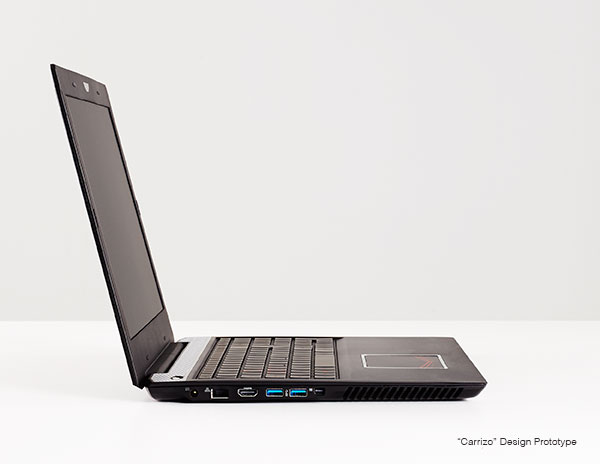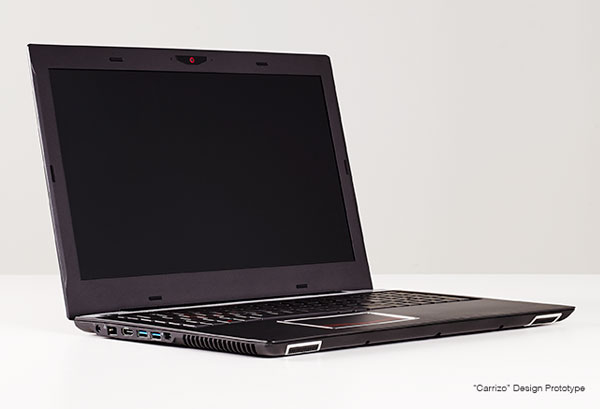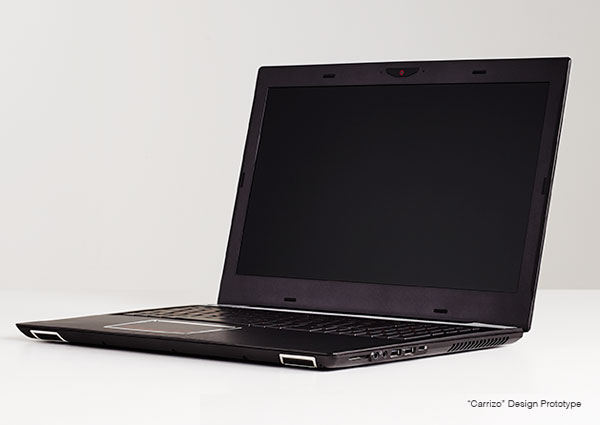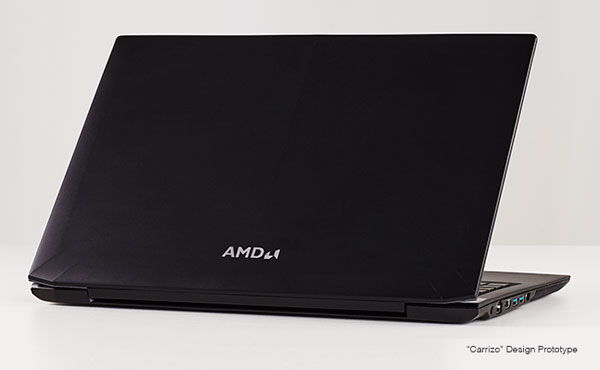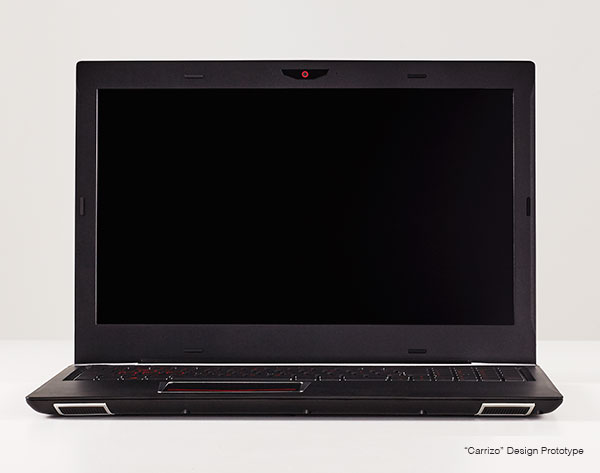First Look: AMD's Carrizo APU Notebook Design
AMD is debuting its high-performance Carrizo and Carrizo-L system-on-a-chip design at the 2015 Consumer Electronics Show (CES), and we're the first to offer pictures of the prototype.
While Carrizo-equipped systems won't be available until the mid-year time frame, the company has working silicon in hand. AMD has thin and light prototype systems jointly developed with Shuttle Inc. and is showing them off at CES. According to Kevin Lensing, Senior Director, Product Management, AMD, "It's a 'Carrizo'-based system sporting an upcoming mobile discrete GPU and it delivers exceptional, unprecedented gaming performance in a thinner and lighter platform than previously possible due to the energy efficiency and performance focus we have in 'Carrizo.'" The CES demonstrations are limited to private appointments and aren't available to the general public, but Tom's Hardware will be there and we look forward to seeing what Carrizo can do.
Tom's also touts the company's new unified platform strategy: "Our scalable approach, which hasn't been used in the PC industry for many years now, addresses the complete stack from top to bottom with a single platform, meaning that our OEM partners will be able to use "Carrizo" and "Carrizo-L" to serve a wide range of the market – spanning form factors and price points from all-in-ones and mainstream notebooks, to ultra-thin and light performance and gaming notebooks – without needing to design, develop, and validate multiple platforms."
Carrizo checks a lot of boxes: a unified SoC platform that the company claims can scale from mainstream to enthusiast class performance, the new Excavator CPU core, the GCN graphics architecture, Mantle and DirectX 12 API support, Project FreeSync support, Heterogeneous System Architecture (HSA) 1.0, an HEVC hardware decoder for 4K video, and an integrated ARM TrustZone processor on die.
Despite the impressive feature list, it will likely come down to plain-and-simple ability. Is Carrizo capable of generating playable frame rates in games while using an acceptably low amount of battery power? AMD claims that "…'Carrizo' delivers HD and Ultra HD graphics horsepower, increased compute performance and next-generation mobile gaming," and our discussions with representatives lead us to believe that the company considers this an important aspect of Carrizo's arsenal. We've also been told that technology research firm Gartner has indicated that thin and light notebook gaming is on the rise.
We're inclined to agree. If Carrizo has the chops to handle PC games in HD while maintaining modern power-efficiency expectations, it would open a new market up to AMD. Imagine a capable, reasonably-priced gaming notebook equipped with a built-in FreeSync monitor. But AMD has had capable on-die graphics chipsets for some time now. The question is, can it get power usage under control?
John Byrne, AMD's president and general manager of the company's computing and graphics business unit, has gone on the record saying that "…we're bringing a brand new graphics architecture integrated into Carrizo. This will be our biggest leap ever from an energy efficiency perspective." We're not privvy to details regarding how the company has tweaked GCN in order to achieve this purported leap in energy savings, but we've recently noted that AMD Appears To Have Power-Saving 'Dynamic Frame Rate Control' Feature Incoming. We're told this is partially responsible, but it's just one piece of the puzzle. Either way, we can't wait to get our hands on a Carrizo for testing later in 2015.
[ADDENDUM] We have since had an opportunity to see Carrizo running in three systems at CES. The first was the shuttle-developed laptop pictured above. In person it looks much more impressive with a red illuminated keyboard and stylish cutouts, like something you'd see on ASUS' ROG series. We weren't allowed to take a picture, unfortunately, but it left a positive impression.
Get Tom's Hardware's best news and in-depth reviews, straight to your inbox.
The second system was running Lego Batman. It's a nice-enough looking game, and Carrizo ran it well, but certainly not one of the most demanding titles out there. We'd rather have seen something that requires a little more horsepower.
The third system showed 4K video playback, which is accelerated by Carrizo's new HEVC hardware decoder block. It played wonderfully smoothly next to a Core i3 that was obviously stuttering. We're told that Carrizo uses about 5 to 6% CPU utilization during this test, while the Core i3 was almost maxed out.
That's the extent of hardware demos we were shown. The only other information we gleaned is that Carrizo-L will draw in the 15 to 19 Watt neighborhood, while Carrizo will have a TDP up to 35 Watts. This certainly puts AMD's power draw in the neighborhood of Haswell-U and Broadwell-U chips. We'll have to wait until we can perform tests to see where performance sits, and to find out what Carrizo design wins will be priced when they hit retail before we can assess whether it will be the game-changer AMD suggests it will. [/ADDENDUM]
Follow us @tomshardware, on Facebook and on Google+.
Don Woligroski was a former senior hardware editor for Tom's Hardware. He has covered a wide range of PC hardware topics, including CPUs, GPUs, system building, and emerging technologies.
-
shogunofharlom As a longtime AMD user, I'm telling you... don't get your hopes up. AMD cant make decent cpu's or drivers, but their PR department is top notch. Expect the usual %10 performance increase with a %5 battery life gain. They will use the designs marginally increased efficiency to increase clock speeds, but not so much to negate a net a battery-life gain.Reply -
Fearnot Better be a FM2+ Carrizo also or AMD has completely abandoned the desktop till 2016. Also don't bother bringing up the rebadged 2012 8350's that they are still trying to sell like new.Reply -
AJSB I don't give a <<blank>> about Notebooks, i had two and swear to never again, i only use/build mini-ITX for several years.Reply
Better AMD have that Carrizo thing in a dropin FM2+ socket or else i will be VERY disapointed.
Still using Trinity APUs in FM2+ MoBos and WON'T upgrade untill Carrizo arrives to Desktop. -
Rookie_MIB I certainly am rooting for AMD to get their *#&@ together and get this power usage under control. In situations where power is not an issue, I certainly like AMD's performance/$ ratio as I can easily put together a competent desktop or basic server for a very reasonable price. When it comes down to performance/watt (laptops and htpc) however, I have to go Intel.Reply
J1900 HTPC (10w)
i5 Sandy bridge laptop (zenbook)
AMD Opteron rack server (1u webserver)
Xeon X3450 rack server (big hotswap VM server and couldn't beat the price)
AMD Phenom II x 2 (freenas media server)
AMD A10-5700 desktop (working computer) -
anxiousinfusion ReplyI don't give a <<blank>> about Notebooks, i had two and swear to never again, i only use/build mini-ITX for several years.
Better AMD have that Carrizo thing in a dropin FM2+ socket or else i will be VERY disapointed.
Still using Trinity APUs in FM2+ MoBos and WON'T upgrade untill Carrizo arrives to Desktop.
Agreed. It's saddening to see AMD basically tell desktop users to go die in a hole. Laptops are the epitome of compromise. -
thd101kf At least for consumers who spend most on their time on entertainment this amd apu will be better than intel who focus too much on pure cpu workloads despite the improvement they have made in igp.Reply -
Vlad Razvan ReplyAs a longtime AMD user, I'm telling you... don't get your hopes up. AMD cant make decent cpu's or drivers, but their PR department is top notch. Expect the usual %10 performance increase with a %5 battery life gain. They will use the designs marginally increased efficiency to increase clock speeds, but not so much to negate a net a battery-life gain.
I don't agree with you on the drivers part. While it used to be true in the past, I consider current AMD drivers to be on par with nVidia's. I currently own an Asus ROG 751JY with an nvidia card, and I have to say - nvida drivers are dissapointing. Issues like BSODs and overheating, or setting the GPU to 100% at idle and on battery power are quite common in today's nvidia drivers. Also, nvidia control pannel doesn't have as many features as Catalyst control center. (I used to have a 7970m in my Precision M6700 before I sold it and got my current machine). I can't belive I'm saying this, but I miss catalyst control center... It even enabled OC by default - I can't seem to OC the 980m regardless of what I try... -
zodiacfml this is going to be the same story all over again versus the Intel's Broadwell, auperior graphics with weaker CPU with higher consumption.Reply -
Dan Ritchie Kaveri was starting to get pretty good. Performance of C++ Amp code was impressive. Looking forward to seeing what HSA adds.Reply
